Michael Saffle
Virginia Polytechnic Institute and State University
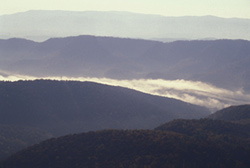
Photo by Bob Veltri.
A little over two years ago, in early 2002, I was asked to teach an upper-division undergraduate course called “Appalachian Folk Cultures.” Previous incarnations of this course had examined issues and artifacts ranging from Jack tales to quilts and gardening. I knew little or nothing about those subjects; although I have taught interdisciplinary humanities courses for more than twenty-five years, my principal professional training and research interests are musicological. On the other hand, I have grown increasingly interested in America’s musical traditions. For the past fifteen years and more I have taught courses on popular song, African American music, and rock. My recent publications include articles on Irish-American music of the Civil War era, images of America in recent Hollywood films, and the Trapp Family Singers’ 1940s and 1950s American tours. I was delighted to have an opportunity to learn more about musical life in southwestern Virginia, where my family and I have lived for a quarter century.
I mentioned almost all of this to Professor Elizabeth (“Betty”) Fine, today Head of the Department of Interdisciplinary Studies at Virginia Tech. During the 2002–2003 academic year Betty served as director of Tech’s Humanities programs within what then was the Center for Interdisciplinary Studies. I also discussed my excitement and reservations with Professor Anita Puckett, today Coordinator of our department’s Appalachian Studies program. Betty and Anita agreed that “my” version of “Appalachian Folk Cultures” would be advertised, informally, as “Mountain Music.” Betty also explained that the course attracted not only juniors and seniors enrolled in such courses, but Masters candidates in Geography, History, and other subjects. My students, in other words, might know more than I did, at least about certain issues.
I did not share all of my thoughts with Betty and Anita, however. At least not right away. Instead, I sat down and made some notes about what I considered perhaps the most challenging aspects of teaching a course on mountain music. Those aspects can be summarized in a single word: class. Not in terms of avoiding that subject as in responding to it. In order to teach “Appalachian Folk Cultures,” I would have to deal with the region’s inhabitants. A few of them would be among my students. Of course, others had already been my students, in other courses. In previous classroom situations, however, I had not been expected to discuss “local” issues. On the other hand, not all of my students would be “Appalachian.” To what extent, I asked myself, would we share particular interests in mountain music? And would we get along with one another?
I shall pause to define “Appalachia” later in this article. Let me begin by saying merely that many of its inhabitants are European Americans. In other words, white. In many areas they are, literally, WASPS. Which is to say: not merely white, but specifically Anglo-Saxon and undeniably Protestant. Hundreds of thousands of Appalachian men and women are the descendents of English and Scots-Irish immigrants who arrived in North America during the seventeenth and eighteenth centuries. Today, a majority of those descendents are Baptists or Methodists or members of the Church of Christ. Many of them vote Republican.
These facts suggest, stereotypically, the comfortable social circumstances associated with WASPs. Yet Appalachia has long been one of America’s least prosperous areas, its offspring among our nation’s least upwardly mobile citizens. America is supposed to be a classless society. But it is not. And, in a world of class distinctions, Appalachia is, or has been, primarily lower-class. Not because of its inhabitants’ races or ethnicities or sexual preferences. But because of poverty.
Since the 1960s “race” has increasingly become a respectable, even a required, subject in our nation’s textbooks and classrooms. The Civil Rights Movement, Brown vs. the Board of Education, and Black Studies programs have brought large numbers of European-American students into intellectual contact with African American issues. These phenomena have not “solved” many racial problems, but they have made them more visible. Even today, however, “class” is all but ignored in a great many educational circumstances. I have heard colleagues of mine proclaim, without qualification or pause, that poverty is a black issue, or an Hispanic issue, or an immigrant issue. Period. Yet Appalachia remains poorer than most of the rest of the United States—and this in spite of the fact that many Appalachian men and women are not only white, but can boast as many as twelve generations of American forebears!
Any discussion of traditional Appalachian music and the people who have made it must come to grips with these facts. At Virginia Tech, however, issues concerning class can be difficult to discuss. Tech’s history and culture are studded with class contradictions and conflicts. Ours may be America’s only comprehensive, research-oriented university where “hillbilly” is occasionally used not merely as a term of approval, but of self-identification. Yet, to a considerable extent, Tech’s administrators and many members of its community have distanced themselves from their own geo-cultural surroundings. To say something about my own experiences teaching mountain music, therefore, I must begin by saying something about my experiences—and those of many others—at Virginia Tech.
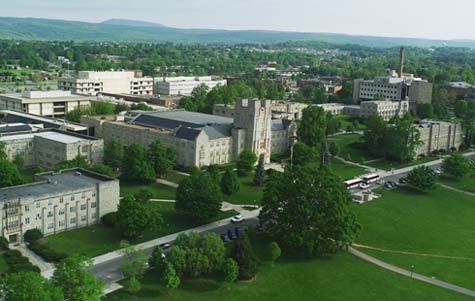
Founded in 1872 as the Commonwealth of Virginia’s Land Grant institution of higher learning, Tech was originally known as the Virginia Agricultural and Mechanical College. The words “and Polytechnic Institute” were added in 1896, and in 1944 the school was officially renamed “Virginia Polytechnic Institute.” Only during the 1960s, however, did Tech begin to emerge as a comprehensive university. In 1965, for example, the Bachelor of Arts degree was reinstated; it had last been offered in 1886. Tech’s first-ever official music course was taught in 1967. In 1970, the words “and State University” were officially added to what was already a rather long name. The result of these and other efforts have turned an all-male, Corps of Cadets “college” into a research institution of international caliber (Kinnear and Robertson). By 1978, when I accepted a joint appointment in Music and Humanities, Virginia Polytechnic Institute and State University boasted undergraduate and graduate degree programs in English, Foreign Languages, History, Philosophy, Political Science, and Sociology as well as a host of technological specialties. Between 1978 and 1980, Tech hired well over 200 full-time, tenure-track assistant and associate professors: one-third of all new tenure-track appointments made during those years at accredited colleges and universities throughout the United States.
The 1970s and early 1980s were years of enormous change and growth at Tech. Nevertheless, the school’s military, mechanical, and even agricultural origins still make themselves felt almost everywhere on campus. A majority of Tech students still pursue degrees in agriculture, architecture, business, and engineering. More than a few old-timers still consider fine- and liberal-arts programs “marginal” endeavors. On the other hand, the humanities continue to exfoliate and even to flourish. During the 2003–2004 academic year, for example, Tech’s English Department launched an MFA program in Creative Writing. Other departments, including my own, are preparing to offer new graduate certificate and PhD programs in liberal arts areas. Last year, too—and in collaboration with the University of Virginia and the Virginia Foundation for the Humanities—Virginia Tech assumed leadership of the South Atlantic Humanities Center, underwritten in part by the National Endowment for the Humanities.
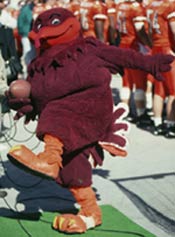
Tech’s history and demographics have set it apart from almost every other university insofar as the mountains are concerned. Unlike Appalachian State University in Boone, North Carolina, Tech has been a bit insecure about anything that suggests coal mines (save in terms of mining engineering), moonshine, and ramshackle outbuildings. Yet Tech students and their mascot are known as “hokies.” Not in the familiar sense of “hokey” (meaning sentimental or phony), but in the regional sense of “hokie” (meaning a castrated turkey). The “Hokie Yell,” today mostly supplanted at Tech sports events by the “Tech Triumph” fight song, is—according to legend—the noise the bird makes as it says farewell to its lost sexual-identity signifiers. Yosef (from “yo’ self”), Appalachian State’s mascot—originally a lazy, genial hillbilly, today a brawny mountain man—is, perhaps, only a little more explicitly regional. Tech, in other words, is proud of its populist origins and leanings. Many Tech students make fun of the University of Virginia, often referred to as “UVa” (pronounced you-vee-A) or “Charlottesville.” Familiar throughout the South as “The University” and “Mr. Jefferson’s University, UVa is Tech’s traditional football rival. Local folklore holds that Charlottesville men are snobbish sissies, their women (collectively known as “Muffy”) the products of pretentious charm schools. On the UVa campus, however, folklore holds that Tech men are bumpkins or nerds, infatuated with their pocket calculators and PCs, while their women are farm girls or geeks.
Prejudices of these kinds may make for exciting football games, but the facts contradict them. For decades Tech’s undergraduate population has largely come from “Northern Virginia” (or NoVa), not from the mountains. In 1995, the last year for which complete figures are available, 5,320 students—35% of the student body—came from the comparatively small but densely populated region immediately adjacent to Washington, DC, and composed of Fairfax, Fauquier, Loudon, and Prince William counties as well as the cities within or adjacent to them. Only 2,778 students, or 18%, came from “Western Virginia”: the much larger but less populated region that includes and lies to the west of Allegheny, Botetourt, Franklin, Pittsylvania, and Roanoke counties. Tech’s mascot may be rural, but many of its graduates are urban and suburban, the children of well-to-do, even wealthy professional parents. More than a few Hokies drive BMWs and spend their holidays cruising the Caribbean. Students from western Virginia are more often the children of lower-class parents; some of them are the first members of their families ever to attend college. Others, however, are anything but stereotypically “mountain.” And proud of it. To make the situation more complex, Tech increasingly draws students from other parts of the nation. In 2003–2004, the top five “feeder” states—in order of numbers of students sent Techward—were Maryland, Pennsylvania, New Jersey, North Carolina, and New York. Nor is this all: Tech boasts a surprising number of foreign undergraduates and an even higher proportion of foreign graduate students. Last year I had Belgians, South Africans, and Saudi Arabians in my classes; one of my Honors students came from Taiwan, another from Zimbabwe.
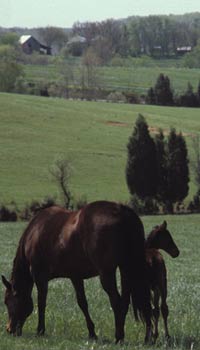
Tech, then, sometimes views itself as a multicultural island “lost” in a sea of mountainous monoculturalism. In Blacksburg, itself located in Virginia’s Montgomery County. But not of Blacksburg. And thus not “mountain.” Many southwestern Virginians would agree, although not all of them would approve. One bumper sticker indigenous to the region reads: “Don’t Montgomery Giles County.” (Giles County, which lies immediately to the north of Montgomery, is poorer, less elitist, and much less heavily “bought in” to Virginia Tech and higher education than Blacksburg and its immediate surroundings. The local equivalent, in other words, of those 1970s Ecotopian bumper stickers that read “Don’t Californicate Oregon.”) “Avoid PhD Pollution,” a phrase popular prior to the 1970s, is still occasionally bandied about by “locals.” Common belief has it that university professors drive foreign cars. Locals or “grits” (from the name of a popular southern breakfast food) prefer pickup trucks. A stereotypical town-vs.-gown situation, and one that conceals as much truth as it reveals.
If Tech truly is “in” but not “of” Appalachia, then “Appalachia” must not be exclusively geographic. What is it, then? An issue central to Appalachian Studies as an academic specialty is the on-going attempt to define the field in terms of its boundaries and subject-matter. Even if one excludes the Maritime Provinces of Canada as well as New England, New York State, New Jersey, and Pennsylvania—all of which contain portions of the Appalachian cordillera—it can be difficult to determine just where “the Southern Highlands” begin and end. Several important studies of Appalachia have drawn upon ethnographic information, patterns of cultural behavior, and the demographics of poverty as well as political mandates in order to define “Appalachia” in terms of the counties believed to comprise it. In 1910, for example, John C. Campbell included Montgomery County, where Blacksburg and Virginia Tech are located, in his survey of the region (Campbell). Campbell’s “extensive travels” and “dedication to accuracy” give us, in the words of one expert, “‘the one scientific project fit to serve as benchmark’ for later regional comparisons” (qtd. in Ergood 31).
In 1962, Thomas R. Ford and his colleagues rearranged Campbell’s boundaries, removing Bedford, Franklin, and other Virginia counties—as well as portions of Alabama, the Carolinas, Kentucky, Tennessee, and West Virginia—from their map of the region. According to them, however, Montgomery County remained “Appalachian.” In 1965, however, the US Congress, acting on behalf of the recently established Appalachian Regional Commission (or ARC), excluded Montgomery county—meaning: Blacksburg and Virginia Tech—from ARC-based programs. At the same time, Congress added large parts of Mississippi, New York state, Ohio, and Pennsylvania to ARC maps of “Appalachia.” The Ford and ARC decisions were based largely on economic and political criteria, Campbell’s largely on cultural and geographic criteria. Interestingly enough, Tech’s own division of the Commonwealth into “Central,” “Northern,” “Western,” and other regions flies in the face of Campbell’s, Ford’s, and the ARC’s pronouncements. Tech’s “Valley” region, for example, comprises not only “Appalachian” counties such as Clarke, but “Northern” counties such as Fauquier—the last one of Campbell’s “Appalachian” choices! Everybody, it seems, defines these things differently. And different rules bolster each and every definition.
As one might expect, a great many Tech students have vigorous, although often inconsistent, attitudes toward their immediate surroundings, “hillbillies,” “mountaineers,” and their own socio-professional aspirations. Some locals eschew anything pertaining to stereotypically rural or regional lifestyles. Others, including legal residents of New York and New Jersey, “go native.” Many students love mountain and country music; others listen only to rock, or to jazz, or to classical music, or to “real” country music. More than a few born-and-bred Blacksburg High School graduates move out of state and never come back. A few graduates of Pennsylvania and Maryland high schools settle in Blacksburg for the rest of their lives.
In his editorial introduction to this Cleveland panel, James Deaville wrote that teaching “controversial” music, including that of Appalachia, involves teaching material “positioned as inferior” throughout music of America. This music, Deaville correctly maintains, is widely considered the creation of a subaltern culture. How, then, to teach it? Especially when the teacher (me) is an outsider? True, I have lived for several decades in Montgomery County. But I wasn’t born here, and I didn’t go to school here. Until a few years ago, in fact, I’d never attended an “old-timey” concert; the “folk music” I grew up with back in the 1960s was sung and played—on phono records—by the likes of Joan Baez, Woody Guthrie, and Pete Seeger. These last details, though, I consider unimportant. I never heard Liszt play, but I feel comfortable writing about his German concert tours of the 1840s. In 2002 I felt not only comfortable with, but excited by, learning more about mountain music.
More problematic for me was my students. Who would they be? What would they think about “hillbillies”? Would they be mostly locals or novas? “Preps” (which is to say, the upwardly mobile; those who prepared carefully for college)? Or grits? What would they know—if anything—about the Child ballads, parlor songs, shape-note singing, the Carter family, or bluegrass banjo music? Would they know who Béla Fleck was? Or Alison Krauss? Would they have seen O Brother Where Art Thou? or Songcatcher? More to the point: what might they have thought about it?
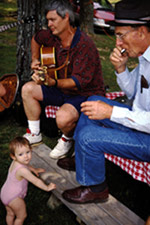
What I discovered, shortly after Fall Semester 2002 began, was that the thirty-odd students I encountered in class twice each week were indeed a mixed bag. Four of them were pursuing Master’s degrees in economics, philosophy, or political science. Five of them, on the other hand, were freshmen—and this in spite of regulations requiring “Introduction to Appalachian Studies,” a lower-division course, as a prerequisite, as well as “permission of the instructor.” About half of them were NoVas or came from out-of-state; the rest were locals and a few of them self-professed “country folk.” (The most irritating of this last contingent was a brash fellow who answered every question for the first four or five weeks of class in imitation of Karl Childers, the protagonist of Billy Bob Thornton’s movie Slingblade.) Two young women were nieces of Ralph Stanley, for decades a mountain-music legend and today known around the world for his contributions to the Coen Brothers’ film O Brother, Where Art Thou? A third young woman was just learning to play clawhammer banjo. A fourth came from a family of dulcimer makers. About a half-dozen of these students, “city” as well as “country,” men as well as women, could sing a verse or two from “the old ballads,” but none of them had ever heard of Francis James Child. Most of them knew who the Carters were and several owned Carter Family CDs; only one of them had ever seen a shape-note hymnal, however, and even she had no idea that shape-note singing has been and still is practiced throughout the south by blacks as well as whites. More than a third of the class had never before taken a course in anything “folksy.”
In these virtual pages I shall not attempt to review precisely what I taught or why. I made my share of mistakes. One of them I very much regret: I scolded three students for talking during a musical demonstration and snapped at one of them when he refused, after class, to apologize for his behavior. Anita Puckett later explained to me that a lot of southwestern Virginians perceive music largely as a social lubricant and aren’t used “merely” to listening to it. Here was cultural conflict in action! I apologized, the student apologized in turn, and things settled down. On another occasion, one I do not regret, I had to ask the Billy Bob Thornton wannabe to cut out his asides about “hillbilly wimmin.” We had been discussing sexual stereotypes pertaining to Appalachia and “John” (not his real name) just couldn’t resist a few rude remarks. Nor were all of my assignments equally effective. I began by discussing a large slab of D. K. Wilgus’s classic monograph on songcatchers. It was simply too difficult for my charges to grapple with. Nor did all of my students enjoy the taped examples I asked them to copy and listen to at home. Perhaps the most offensive comment of the term came from one young prep, who complained that “all of this stuff sounds alike.” To my ears, a 1930s field-recorded fiddle rendition of “Sally Goodin” in few ways resembles Les Paul’s arrangement of “Honolulu Rock-a-Rolla.” Although, to give each side its due, I pointed out that these and other examples of mountain or mountain-influenced music have been lumped together as “country” by a lot of people. There was a tense moment or two before a few of the students agreed with me and discussion resumed.
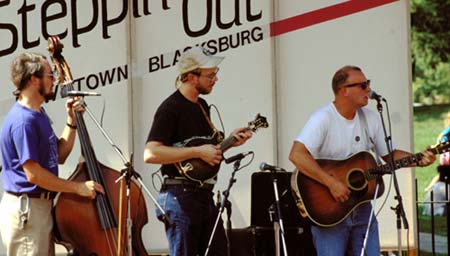
In the syllabus I drew up I sought to examine two principal issues. For me the first, in terms of importance and scope, was authenticity. To what extent and/or in what ways can we talk about “authentic” mountain music? Crucial to this part of the course was Richard Peterson’s stimulating discussion of how authenticity was and continues to be manufactured in country-music circles. I wanted to help my students deconstruct Appalachia’s cultural-musical boundaries. I wanted them to understand how and why “mountain” music served during the 1920s and 1930s as fodder for the emerging commercial “country” music machine. How and why, for instance, traditional subjects gestures can be found even in so-called “Hawaiian” music of the 1950s, as well as in the “cowboy” ballads and songs popularized by Republic Pictures. These kinds of manufactured traditions teach us not only that Appalachian music has traveled much of the world, but that it cannot often be distinguished absolutely from other forms of traditional and commercial popular music. The Carter Family is a case in point: even in their earliest performances and recordings, the Carters combined aspects of balladry, hymnody, gospel music, parlor song, and popular gesturing into what many people today consider quintessential—and “authentic”—Appalachian music. In considering these issues, Peterson explains that such conflations are also “authentic” if accepted as such.
Second in importance for me as subject-matter, but first in terms of class discussion, was origins. How far back can we meaningfully go to learn about the music made in the southern Appalachians? In order to understand something of the documentary record, I asked my students to read several articles about traditional American music. I also asked them to examine a few of the early reports about mountain music-making, and I expected them to know something about the ballads and tunes collected in the “southern highlands” from the end of the Civil War through the 1930s. I assigned portions of George Pullen Jackson’sWhite Spirituals in the Southern Uplands, which deals with the rich and complex history of “Kentucky Harmony” and shape-note singing, as well as Benjamin Filene’s “Setting the Stage,” which—among other things—discusses the roles played by Child, Cecil Sharp, and other field researchers into traditional American music. The opening chapter of Robert Cantwell’s Bluegrass Breakdown, largely devoted to iconic “mountain” musician Bill Monroe, provided insights into mountain life as the source of and inspiration for the development of a distinctive musical culture.
To stimulate discussion of these and other issues I drew heavily upon Hollywood films. Students watched, then applauded or jeered clips from such diverse movies as L’il Abner, Melvin Frank’s 1959 film adaptation of Johnny Mercer’s Broadway musical score—itself based on Al Capp’s mythical Dogpatch and its inhabitants’ shenanigans—and Deliverance, John Boorman’s 1972 film adaptation of James Dickey’s description of homicidal lunacy in the northern Georgia mountains. Together the students and I debated not only these stereotypical representations of mountain peoples, but to consider the origins of our own attitudes toward “rubes” and “rednecks.”
At no point during the semester did discussion threaten outright disruption, but it became clear that a few students—locals as well as NoVas and other “slickers”—the words became jokes after a while (although the attitudes that underlay them were almost always taken seriously)—didn’t want to talk or even write about the rape scene in Deliverance. Even John balked at commenting on anything that “gay.” Class members were also reluctant to acknowledge that real-life human beings might, in fact, resemble in certain respects such outlandish figures as Daisy Mae, Earthquake McGoon, or (one of my favorites) Senator Phogbound. We quickly agreed that Mercer’s music for L’il Abner wasn’t very “authentic” (even though Mercer himself remains the most successful “southern” composer of popular songs). And we disagreed about the authenticity of the “Dueling Banjos” number in Deliverance—a piece of music, as I pointed out, that was published during the 1950s and had to be considered “commercial” as well, perhaps, as “traditional.”
Finally, a few words on controversy. In “Appalachian Folk Cultures” there was little of it, at least on the surface. I did not seek to stimulate argument for its own sake, and most of the students seemed happy to avoid it. There was no name-calling, no overt ridicule of country (or city) ways. Yet the course as a whole struck several people on campus as … it is difficult to find the proper words. A few were enthusiastic, of course. Others, however, found the course itself not so much “offensive” as “unnecessary,” even “time-wasting.” Deaville is correct: teaching “marginal” material continues to be “regarded as transcending the traditional boundaries of appropriateness established within the academy.” Not so much in my classroom, however, as in a few of my colleagues’ offices. It was the course itself that “offended”—I use his word—one professor in our Music Department, a department I cheerfully left in 1996, when the Center for Interdisciplinary Studies provided more secure and broad-minded home for several programs on the Tech campus.
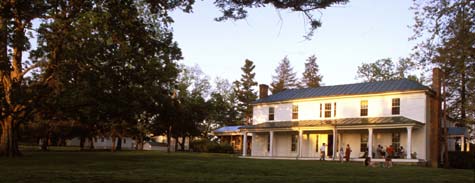
Perhaps the “problem,” to the extent that it exists, can be summarized as follows: Why talk about what we already know? (“We,” in this case, being those who have doubts about Appalachian Studies courses, or at least about “Appalachian Folk Cultures” and traditional local music.) We already know there’s tunes in them thar hills. We know we despise them, or tolerate them, or laugh about them. We know they’re not the tunes we want to listen to on the radio. Not classical music, or jazz. And certainly not on good car radios: not in Audis or BMWs. That stuff’s okay for truckers, maybe—although I myself have difficulty imagining a large market among commercial truck-drivers for shape-note singing or the Flecktones, much less for Broadway show tunes. Perhaps, however, this merely reflects my own cultural prejudices.
We all have them. Prejudices, that is. Don’t let anybody tell you otherwise. Perhaps the best thing for me about teaching a course on mountain music was learning more about how I, myself, saw and experienced the world immediately surrounding me. I believe that everyone, or almost everyone, in class improved his or her understanding of the cultural baggage we carry with us. A few students were moved to jettison some of that baggage. I tried to lose a little of it too. We listened to a lot of good music. Most of the students gave respectable class presentations and wrote satisfactory final examinations. A few did brilliant work. And, when exams were over, we all got to go home for the Christmas holidays just as the season’s first snow fell on the Blue Ridge.
Next Essay (Link to “A Historical Perspective on Teaching Controversial Aspects of African-American Music”)
Works Cited
Books and Articles
Boman, Rex. “Counties line up for a piece of Appalachia (Or, to be blunt, a slice of federal aid dollars planned for the region)”Richmond Times-Dispatch. 21 December 2003.
http://www.timesdispatch.com/servlet/Satellite?pagename=
RTD%2FMGArticle%2FRTD_BasicArticl&c=
MGArticle&cid=1031772729481.
Campbell, John C. The Southern Highlander and His Homeland. New York: Russell Sage, 1921.Lexington: University of Kentucky Press, 1969.
Cantwell, Robert. Bluegrass Breakdown: The Making of the Old Southern Sound. Urbana: University of Illinois Press, 1984.
Dawidoff, Nicholas. In the Country of Country: People and Places in American Music. New York: Pantheon, 1997.
Ergood, Bruce. “Toward a Definition of Appalachia.” Appalachia: Social Context, Past and Present. Ed. Bruce Ergood and Bruce E. Kuhre. 2nd ed. Dubuque, IA: Kendall/Hunt, 1983.
Fenster, Mark. “Commercial (and/or?) Folk: The Bluegrass Industry and Bluegrass Traditions.” Reading Country Music: Steel Guitars, Opry Stars, and Honky-Tonk Bars. Ed. Cecilia Tichi. Durham: Duke UP, 1998. 74–97.
Filene, Benjamin. “Setting the Stage: Identifying an American Folk Music Heritage, 1900–1930.” Romancing the Folk: Public Memory & American Roots Music. Chapel Hill: University of North Carolina Press, 2000. 9-46.
Ford, Thomas, ed.The Southern Appalachian Region: A Survey.Lexington: University of Kentucky Press, 1962.
Gentry, Linnell. A History and Encyclopedia of Country, Western, and Gospel Music. Nashville: McQuiddy, 1961. St. Clair Shores, MI: Scholarly Press, 1979.
Jackson, George Pullen. White Spirituals in the Southern Uplands: The Story of the Fasola Folk, their Songs, Singings, and “Buckwheat Notes.” Hatboro, PA: Folklore Associates, 1964.
Kinnear, Duncan Lyle. The First 100 Years: A History of Virginia Polytechnic Institute and State University. Blacksburg: VPI Foundation, 1972.
Malone, Bill C. Singing Cowboys and Musical Mountaineers: Southern Culture and the Roots of Country Music. Athens: University of Georgia Press, 1993.
Peterson, Richard A. Creating Country Music: Fabricating Authenticity. Chicago and London: University of Chicago Press, 1997.
Robertson, Jenkins Mikell. Historical Data Book: Centennial Edition. Blacksburg: Virginia Polytechnic Institute and State University, 1972.
Sanjek, David. “Blue Moon of Kentucky Rising Over the Mystery Train: The Complex Construction of Country Music.” Reading Country Music: Steel Guitars, Opry Stars, and Honky-Tonk Bars. Ed. Cecilia Tichi. Durham: Duke UP, 1998. 22–44.
Shapiro, Henry D. Appalachia on Our Mind: The Southern Mountains and Mountaineers in the American Consciousness, 1870–1920. Chapel Hill: University of North Carolina Press, 1978.
Tribe, Ivan M. Mountaineer Jamboree: Country Music in West Virginia. Lexington: Univeristy of Kentucky Press, 1984.
Wilgus, D. K. Anglo-American Folksong Scholarship since 1898.New Brunswick, NJ: Rutgers UP, 1959.
Sound Recordings
The Carter Family. The Carter Family: Country Music Hall of Fame Series. MCA MCAD 10088, 1991.
Fleck, Béla and the Flecktones. Outbound. Columbia CK 62178, 200.
Krauss, Alison & Union Station. So Long So Wrong. Rounder CD 0365, 1997.
Li’l Abner: Original Broadway Cast Recording. Columbia SK 87700, 2002.
O Brother, Where Art Thou? Mercury 088 170-072-2, 2000.
Paul, Les. Les Paul: The Legend and the Legacy. Part 4. Capitol CDP 7 97658, 1991.
Smith, Harry, ed. Anthology of American Folk Music. Vol 3. Folkways SFW 40090/A 28750, 1997.
Songcatcher: Music from and Inspired by the Motion Picture.Vanguard 79586-2, 2001.
Titon, Jeff Todd, comp. Old-Time Kentucky Fiddle Tunes. UP of Kentucky, 2001.
Wiregrass Sacred Harp Singers. Desire for Piety: Songs from the B.F. White Sacred Harp. New World 80519-2, 1997.
200 Years of American Heritage in Song: 100 Song Collection.CMH CD 1776, 1991.
Marching Virginians. “Tech Triumph.” By Wilfred P. Maddux and Mattie Eppes. Recorded material courtesy of the Athletics Prgrams of Virginia Tech.
Films
Deliverance. Dir. John Boorman. Warner Brothers, 1972.
Li’l Abner. Dir. Melvin Frank. Paramount, 1959.
O Brother, Where Art Thou? Dir. Joel Coen. Buena Vista, 2000.
Slingblade. Dir. Billy Bob Thornton. Miramax, 1996.
Songcatcher. Dir. Maggie Greenwald. Lion’s Gate, 2000.
